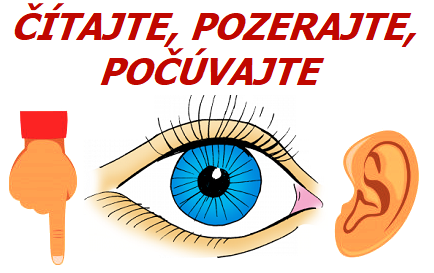15 Masmédiá - MASS MEDIA :)
Vytvorené: 27. 02. 2014 Tlačiť
a) Kinds of mass media (their usage, advantages, disadvantages)
Mass media are considered to be a modern instrument of communication whose task is to mediate and broadcast information from all over the world. Apart from that, mass media should educate and entertain us. In our society we are in daily contact with different types of mass media, including newspapers, magazines, radio, TV and internet.
There is a wide choice of mediums available. We can choose the one, which is the best for us. For people, who like reading, are newspapers the best source of information. There is only one disadvantage, if you want to get the latest information; you have to buy newspapers early in the morning. People who do not like reading newspapers or think it's too expensive, can listen to the radio or watch TV to be informed. If you listen to the radio, you can´t see any pictures, but you can do many things during listening. Many people prefer watching TV because it´s more interesting and takes less time than reading. The result of watching TV is the fact that we don´t move, only sit and eat what can lead to health problems.
b) The press (newspapers, magazines, articles), how to choose them, where to buy them - favourite columns
Press is the oldest information instrument. It can be divided into several groups. Maybe one of the most common source of information are newspapers. They are issued every day. Basically, there are two types of newspapers: serious papers and the tabloids. We have only a few serious newspapers, such as Pravda or Sme. The serious newspaper in Britain is The Times. The main topics are about economics, politics, social life, sports and business news. They also contain a great variety of national and international news. The best selling daily is the tabloid Nový Čas. It is focused on sex scandals and the hottest gossips. The most popular British tabloid newspapers are The Sun, The Daily Mirror or The Daily Mail. The only common thing for these newspapers is sport and the weather forecast, which are almost identical. The second group are magazines which are printed weekly or monthly. They get over international and national news, various articles and stories about pop stars, advertisements and TV programmes. Magazines have usually more pages than newspapers and are colourful. They are usually for people interested in different kinds of sports and hobbies, such as gardening, music, cars, knitting and many more. The most widespread magazines for women are Eva and Emma in Slovakia. These magazines contain articles about fashion, make- up, healthy lifestyle and music. The serious magazines are called journals. There are published professional articles written by experts, for example doctors or scientists.
c) Radio, TV (favourite kinds of programmes, ratings)
Radio is very popular and many of us like listening to the radio throughout the day just as a background no matter what we are doing. There are redactors who report to the people the latest news and they complete it with good music. We have about 20 radios in Slovakia and there are different kinds of radios: private independent radios (Fun radio), local radios (Tatry) and state radios (Slovensko 1). The private radios broadcast more advertisements than state and local radios. There is usually a great variety of radio programmes to choose from: news programmes and weather forecasts, chat shows, educational programmes, quiz shows, breakfast/morning shows, phone-in programmes and finally documentaries.
Television is a popular source of information and many people like watching TV in their free time. You can watch discussion programmes, soap operas, quiz shows, reality shows, live sports coverage, documentary films, lively debates and of course films and cartoons in TV. There are many channels to choose from. In Slovakia we have three public television stations. STV 1 usually broadcasts news and educational programmes and films in the evening. STV 2 specialises in documentaries and educational programmes. STV 3 often broadcasts live football or hockey matches. Some towns and areas also have local TV stations showing mostly local news. Commercial stations, such as TV Markíza and TV Joj are quite popular because they try to satisfy viewers´ expectations. They show new films, entertaining programmes and shows.
d) The influence of mass media on life of an individual, family and society
The influence of mass media has grown exponentially with the advance of technology. In the present, majority of people in the society depends on information to remain connected with the world and do their daily activities. A common person usually wakes up in the morning, checks the TV news or newspaper, goes to work, makes a few phone calls, eats with his family and makes decisions based on information that he has either from co workers, TV news, friends and so on. The media has a huge impact on society in shaping the public opinion in different ways. Media makes billions of dollars by advertising. We buy what we are told to buy by the media. These are the effects of mass media especially in teenagers. There are some positive and negative influences in young people due to these ad campains in the media. A quiz show on education will promote literary activity in the youth. However, a negative influence in teenagers is the use of guns and ammunition by celebrity movie stars. Kids that are starting to grow and are shaping their personality can become aggressive or they can lose a sense of distinction between reality and fiction.
e) The Internet and its influence on a person and society
Internet is in reality the summary of all mass media. Nowadays many people don´t hear the latest news from radio or read about it in the papers, but on the Internet. We can use search engines like Google or Yahoo to find every kind of information. E-mail enables us to communicate and send information or documents. Young people use chat to communicate. Internet can be used for education, working or just for fun.
![]()
· Simulácie z fyziky· O Slovensku po slovensky· Slovenské kroje· Kurz národopisu· Diela maliarov· Kontrolné otázky, Domáce úlohy, E-testy - Priemysel· Odborné obrázkové slovníky· Poradňa žiadaného učiteľa· Rýchlokurz Angličtiny. Rozprávky (v mp3)· PREHĽADY (PRIBUDLO, ČO JE NOVÉ?)Seriály:· História sveta (1÷6)· História Slovenska (1÷5)· História módy (1÷5).
Členstvo na portáli
Poznámka pre autora
Copyright © 2013-2025 Wesline, s.r.o. Všetky práva vyhradené. Mapa stránky ako tabuľka | Kurzy | Prehľady |






